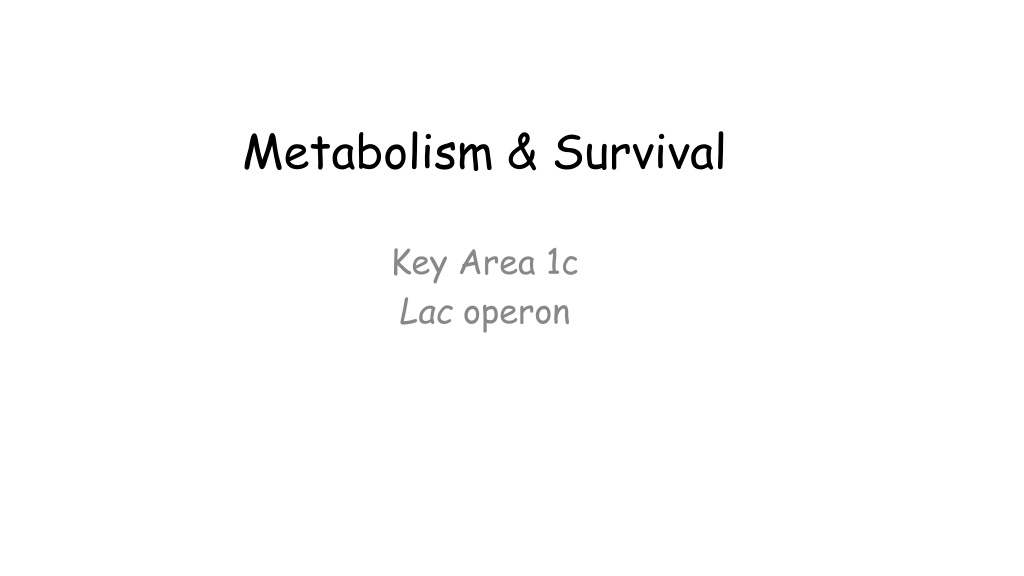Understanding the lac Operon and Gene Induction in E. coli
Explore the mechanism of gene induction through the lac operon in Escherichia coli, where genes are switched on or off based on the presence of lactose. Learn how enzymes like β-galactosidase are produced only when needed, following the Jacob-Monod hypothesis. This system allows for efficient resource utilization and the regulation of metabolic pathways in response to environmental conditions.
Download Presentation

Please find below an Image/Link to download the presentation.
The content on the website is provided AS IS for your information and personal use only. It may not be sold, licensed, or shared on other websites without obtaining consent from the author. Download presentation by click this link. If you encounter any issues during the download, it is possible that the publisher has removed the file from their server.
E N D
Presentation Transcript
Metabolism & Survival Key Area 1c Lac operon
Learning Intentions Understand how the lac operon works as an example of gene induction
Control of pathways Genes that are not required can be induced (switched on) only when needed. The Jacob-Monod hypothesis gives a possible model for this action.
The Jacob-Monod hypothesis Hypothesised by two famous scientists, this model illustrates how certain genes can be switched on (active) or switched off (inactive) and thus save resources being wasted by making unrequired proteins.
The Lac Operon A good example of the mechanism by which genes can be switched on and off is found in the bacterium Escherichia coli.
Escherichia coli produces the enzyme -galactosidase to digest lactose, to release the glucose that it needs for respiration. The enzyme is only made if lactose is present. When no lactose is present the gene that codes for the synthesis of -galactosidase is switched off. The process of switching on a gene only when the enzyme is needed is called ENZYME INDUCTION
Glucose Galactose Lactose - a sugar found in milk - Galactosidase Enzyme that catalyses the breakdown of lactose + Glucose Galactose
The Jacob-Monod hypothesis The lac Operon (the 1st stage) The gene which codes for -galactosidase is called the structural gene and is part of a DNA chain which includes a regulator gene and a sequence of bases called the operator.
Regulator gene -is a section of DNA responsible for producing the repressor molecule Operator gene - determines whether the structural gene is switched on Structural gene - is responsible for the production of enzymes used in biochemical pathways Repressor molecule - is responsible for combining to the operator gene (lactose in this case).
The Jacob The Jacob- -Monod hypothesis Monod hypothesis (the 2 (the 2nd nd stage) stage) The regulator gene is continually transcribed into messenger RNA. This is used to synthesise a repressor protein.
The Jacob-Monod hypothesis (the 2nd stage) When there is no lactose present the repressor protein becomes attached to the operator. This prevents the structural gene being transcribed, and no enzyme is made.
The Jacob-Monod hypothesis (the 3rd stage) If molecules of lactose are introduced, they bind to the repressor protein molecules.
The Jacob-Monod hypothesis (the 3rd stage) This prevents the repressor protein binding to the operator. Because the operator is free the structural gene is transcribed and the enzyme is made
Lactose is called the inducer because its presence induces synthesis of the enzyme. The -galactosidase breaks down any lactose which is present and when there is none left the repressor protein once again binds to the operator and switches off the structural gene. View the experiment: Scholar Unit 3, Fig 3.2: The effect of -galactosidase enzyme on lactose in milk http://courses.interactiveuniversity.net/vle/scholar/session.controller?action=vi ewContent&contentGUID=e40b97ac-3f87-f6c4-1ddf-df59d0cfc27c
How can I learn this theory? Q s 1-3 p239 Q s 1-2 p245-246 Try the BBC Bitesize Test Do the Biology-online.org tutorial Revise with Scholar Unit 3, Ch3 View the animation: Scholar Unit 3, Fig 3.4: Absence of lactose http://courses.interactiveuniversity.net/vle/scholar/session.controller?action=viewContent&co ntentGUID=27961b23-db58-80f8-1d2a-20cbe3d5fad8 View the animation: Scholar Unit 3, Fig 3.5: Presence of lactose http://courses.interactiveuniversity.net/vle/scholar/session.controller?action=viewContent&co ntentGUID=c9e09eea-6d89-b12c-aa09-2e02312a0c96
Role of Genes The structure and function of all cells are determined by their genes. Each gene on a strand of DNA codes for each protein that the cell requires. To prevent resources being wasted the genes for the proteins required are switched on only when needed. Enzyme induction is the name for the process of switching on a gene, only when the enzyme that it codes for is needed. Image source: library.thinkquest.org























